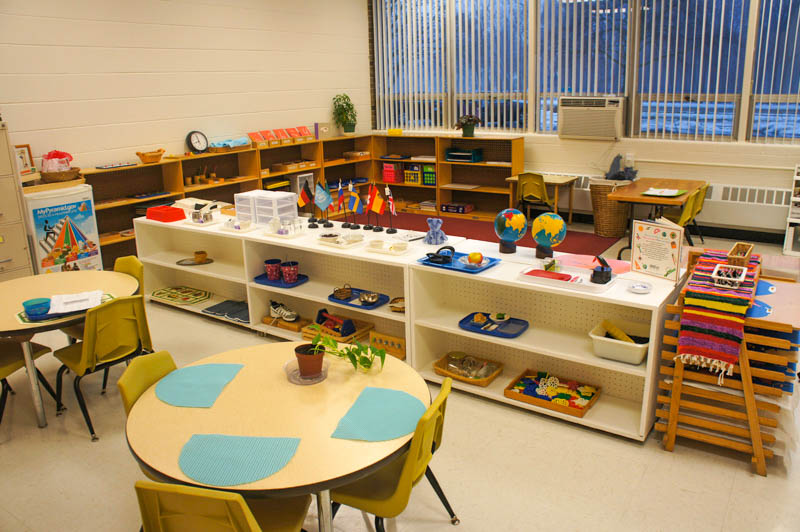
Why is it important that Montessori classrooms are beautiful? June
George explains in this thoughtful post on the nature of keeping a
classroom neat and orderly.
Montessori classrooms are beautiful, neat, orderly and tidy.
Everything is natural, organized, and beautifully displayed. The
atmosphere is one of peace and tranquility, almost Zen-like.
Why?
The classroom is designed this way for a number of reasons, one of which is to help children feel calm and relaxed, setting an appropriate tone conducive to accommodating curiosity, exploration, discovery and what is often characterized as the result – learning.
When you close your eyes and picture traditional classrooms, however, there’s usually quite a contrast in how we envision their configuration.
Many traditional classrooms contain brightly colored objects on the wall and other non-naturally composed but colorful materials, like plastics. All of these are meant to draw attention.
Virtually all of the tools utilized in this type of classroom are purposefully designed to be stimulating.
The Montessori classroom takes a different approach, and Maria Montessori herself has quite a bit to say about the part a child’s environment plays in their development.
Why?
The classroom is designed this way for a number of reasons, one of which is to help children feel calm and relaxed, setting an appropriate tone conducive to accommodating curiosity, exploration, discovery and what is often characterized as the result – learning.
When you close your eyes and picture traditional classrooms, however, there’s usually quite a contrast in how we envision their configuration.
Many traditional classrooms contain brightly colored objects on the wall and other non-naturally composed but colorful materials, like plastics. All of these are meant to draw attention.
Virtually all of the tools utilized in this type of classroom are purposefully designed to be stimulating.
The Montessori classroom takes a different approach, and Maria Montessori herself has quite a bit to say about the part a child’s environment plays in their development.
"It begins with a knowledge of his surroundings."
- Maria Montessori
- Maria Montessori
In The Absorbent Mind, one of her most famous treatises, she
writes about the acquisition of “knowledge”, or how children come to
learn in an environment:
“It begins with a knowledge of his surroundings,” she writes. She then goes on to provoke, in a rather philosophical line of inquiry, “How does the child assimilate his environment?”
As she explains,
“He does it solely in virtue of one of those characteristics that we now know him to have. This is an intense and specialized sensitiveness in consequence of which the things about him awaken so much interest and so much enthusiasm that they become incorporated in his very existence.”
While that may seem a bit overcomplicated, basically, what she is saying is that through the environment the child awakens his or her interest. It is during these periods, what Montessori calls “sensitive periods”, that children are more susceptible to learn.
While traditional classrooms seize upon this moment to offer external stimulation to provoke internal interest, Montessori subdues the external stimulation, in order to awaken the internal desire to learn.
Montessori offers a shift in thinking about what a learning environment should provide, and she sees this as something that will last a lifetime. “The child absorbs these impressions not with his mind but with his life itself.”
With this perspective, how do you envision learning environments? Does the Montessori classroom as described above sound similar or different to what you or your children have experienced?
“It begins with a knowledge of his surroundings,” she writes. She then goes on to provoke, in a rather philosophical line of inquiry, “How does the child assimilate his environment?”
As she explains,
“He does it solely in virtue of one of those characteristics that we now know him to have. This is an intense and specialized sensitiveness in consequence of which the things about him awaken so much interest and so much enthusiasm that they become incorporated in his very existence.”
While that may seem a bit overcomplicated, basically, what she is saying is that through the environment the child awakens his or her interest. It is during these periods, what Montessori calls “sensitive periods”, that children are more susceptible to learn.
While traditional classrooms seize upon this moment to offer external stimulation to provoke internal interest, Montessori subdues the external stimulation, in order to awaken the internal desire to learn.
Montessori offers a shift in thinking about what a learning environment should provide, and she sees this as something that will last a lifetime. “The child absorbs these impressions not with his mind but with his life itself.”
With this perspective, how do you envision learning environments? Does the Montessori classroom as described above sound similar or different to what you or your children have experienced?